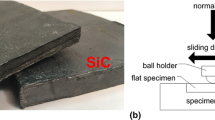Abstract
The oxidation behavior at 973–1 273 K and the effect of oxidation on the room-temperature tribological properties of hot-pressed boron carbide ceramic were investigated. Oxidized samples were studied by X-ray diffractometer and scanning electron microscopy. It is demonstrated that the oxidation results in the formation of a thin transparent B2O3 film, and the oxide film is severely cracked during cooling due to the thermal expansion mismatch between the oxide film and B4C substrate. B2O3 reacts with moisture in air to form boric acid, which is a kind of solid lubricant. The sliding friction factors of oxidized B4C pair are about 0.05–0.08, compared to 0.25–0.35 of the as-received B4C pair. When the oxidation temperature is up to 1 273 K, severe unstability and increase of friction factor are observed. Visual inspection of the wear track reveals that the lubricant film is broken and some debris particles occur on and around the rubbing surfaces, because the friction interface is rough by the severe etching of grain boundaries.
Similar content being viewed by others
References
WANG Ling-sen. Special ceramics (in Chinese)[M]. Changsha: Central South University of Technology Press, 1998. 167–168.
Nishiyama K. Sintering and tribology of boride hard materials[J]. Powder and Powder Metallurgy (in Japanese). 1996, 43(4): 464–471.
Lavrenko V A, Gogotsi Yu G. Influence of oxidation on the composition and structure of the surface layer of hot-pressed boron carbide[J]. Oxidation of Metals, 1988, 29(3/4): 193–202.
Gogotsi G A, Groushevsky Y L, Dashevskaya O B, et al. Complex investigation of hot pressed boron carbide[J]. J Less Comm Met, 1986, 117: 225–230.
Riu D H, Choi R, Kim H, et al. Oxidation behavior and strength of B4C-30%SiC composite materials[J]. Journal of Materials Science, 1995, 30: 3897–3902.
Wagner C. Passivity during the oxidation of silicon at elevated temperatures[J]. J of Applied Physics, 1958, 29(9): 1295–1297.
Thevenot F. A review on boron carbide[J]. Key Engineering Materials, 1991, 56/57: 59–88.
MA Xiang-dong. Nanoscale tribological properties of boric acid[J]. Tribology (in Chinese), 1999, 19: 97–101.
Wuhan University. Inorganic chemistry (in Chinese)[M]. Beijing: High Education Press, 1988. 240–242.
Author information
Authors and Affiliations
Additional information
Biography of the first author: WANG Ling-sen, professor, born in 1938, majoring in special ceramics.
Rights and permissions
About this article
Cite this article
Wang, Ls., Wu, F., Zhang, Js. et al. Tribological behavior of hot-pressed boron carbide with oxidation. J Cent. South Univ. Technol. 8, 89–93 (2001). https://doi.org/10.1007/s11771-001-0032-5
Received:
Published:
Issue Date:
DOI: https://doi.org/10.1007/s11771-001-0032-5




